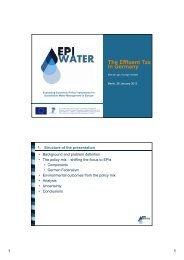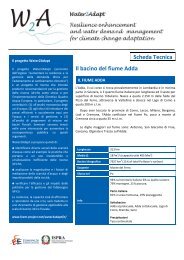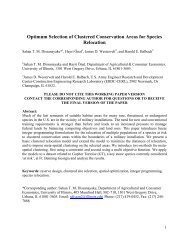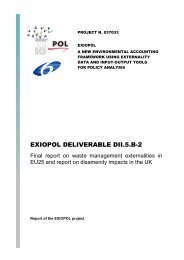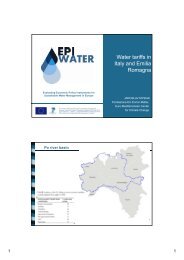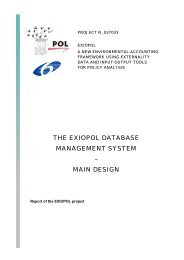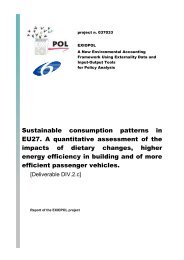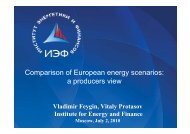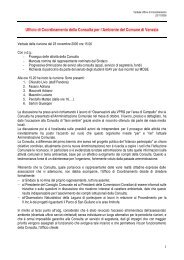Gulf and European Energy Supply Security - Feem-project.net
Gulf and European Energy Supply Security - Feem-project.net
Gulf and European Energy Supply Security - Feem-project.net
You also want an ePaper? Increase the reach of your titles
YUMPU automatically turns print PDFs into web optimized ePapers that Google loves.
<strong>Energy</strong> <strong>Security</strong>: Potential for EU-GCC Cooperation<br />
Figure 1 Cost Reduction of RES-E Investments as Share of Initial Investment Costs (2006) in<br />
a Pessimistic Scenario with regard to Technological Progress according to the “Policy Case”<br />
l<br />
a<br />
i<br />
t<br />
i<br />
n<br />
i<br />
f<br />
o<br />
e<br />
r<br />
a<br />
h<br />
s<br />
-<br />
n<br />
o<br />
i<br />
t<br />
c<br />
u<br />
d<br />
e<br />
r<br />
t<br />
s<br />
o<br />
C<br />
t<br />
n<br />
e<br />
m<br />
t<br />
s<br />
e<br />
v<br />
n<br />
i<br />
)<br />
6<br />
0<br />
0<br />
2<br />
r<br />
a<br />
e<br />
y<br />
e<br />
h<br />
t<br />
n<br />
i<br />
s<br />
a<br />
(<br />
120%<br />
115%<br />
110%<br />
105%<br />
100%<br />
95%<br />
90%<br />
85%<br />
80%<br />
75%<br />
70%<br />
65%<br />
60%<br />
55%<br />
50%<br />
45%<br />
40%<br />
35%<br />
30%<br />
6<br />
0<br />
0<br />
2<br />
8<br />
0<br />
0<br />
2<br />
technologies, but obviously mostly affecting the<br />
cost of wind energy converters, is remarkable.<br />
This increase in investment cost is largely driven<br />
by the tremendous rise of energy <strong>and</strong> raw<br />
material prices as observed in recent years <strong>and</strong><br />
was expected to prolong in the near to mid future.<br />
In this context, the impact of rising energy <strong>and</strong><br />
raw material prices even compensates the cost<br />
reductions achieved due to technological learning.<br />
So, although technology learning is achieved, the<br />
overall investment costs are increasing in this<br />
period. However, still substantial cost reductions<br />
are expected for novel technology options such<br />
as photovoltaics, solar thermal electricity or tidal<br />
stream <strong>and</strong> wave power.<br />
1.3 Opportunity of Renewable <strong>Energy</strong> Sources<br />
to <strong>Security</strong> of <strong>Supply</strong><br />
0<br />
1<br />
0<br />
2<br />
Source: Green-X calculations<br />
2<br />
1<br />
0<br />
2<br />
4<br />
1<br />
0<br />
2<br />
6<br />
1<br />
0<br />
2<br />
8<br />
1<br />
0<br />
2<br />
0<br />
2<br />
0<br />
2<br />
As stated by Ölz et al. 2007, 1 the use of RES<br />
may contribute to increasing energy security due to<br />
several characteristics.<br />
First, since RES mainly represent indigenous<br />
resources, the replacement of imported fossil<br />
primary energy carriers, such as gas or coal, leads to<br />
a reduction of import dependency.<br />
Second, the decentralized availability of RES<br />
<strong>and</strong> predominantly small plant sizes often leads<br />
to decentralized generation resulting in the<br />
2<br />
2<br />
0<br />
2<br />
4<br />
2<br />
0<br />
2<br />
6<br />
2<br />
0<br />
2<br />
8<br />
2<br />
0<br />
2<br />
0<br />
3<br />
0<br />
2<br />
Hydropower<br />
Geothermal electricity<br />
Solid biomass - cofiring &<br />
large-scale plant<br />
Solid biomass - small-scale<br />
CHP<br />
Gaseous biomass<br />
Gaseous biomass CHP<br />
Wind energy<br />
Tidal & wave<br />
Solar thermal electricity<br />
Photovoltaics<br />
following advantages: firstly, less infrastructural<br />
risks as the plants may be located closer to the<br />
dem<strong>and</strong> involving a reduced risk for the grid<br />
infrastructure; secondly, the impacts of potential<br />
shutdowns or blackouts on the electricity system<br />
are reduced.<br />
Third, RES technologies with the exception of<br />
biomass-based applications are not dependent on<br />
any fuel costs. Hence, in contrast to conventional<br />
energy conversion technologies based on the use of<br />
fossil fuels, there are neither fuel price fluctuations<br />
nor risks. Furthermore, the use of RES technologies<br />
in the electricity market under certain support<br />
conditions may have an impact on electricity<br />
prices. In this way, Sensfuß et al. 2008 calculate the<br />
impact of wind power feed-in on electricity prices<br />
using the example of Germany. 2 Following the<br />
basic mechanism of electricity markets, where the<br />
operation of electricity generation plants is selected<br />
according to the merit order of the marginal costs,<br />
wind electricity may replace generation options<br />
with high marginal costs, as for example, gas<br />
turbines, in periods of peak load. Thus, electricity<br />
prices are affected by the wind power feed-in.<br />
Finally, a diversification of the existing power<br />
plant portfolio through an increased use of RES may<br />
lead to the portfolio effect <strong>and</strong> therewith reduce risks.<br />
Figure 2 summarizes the opportunities identified for<br />
RES to contribute to security of supply.




